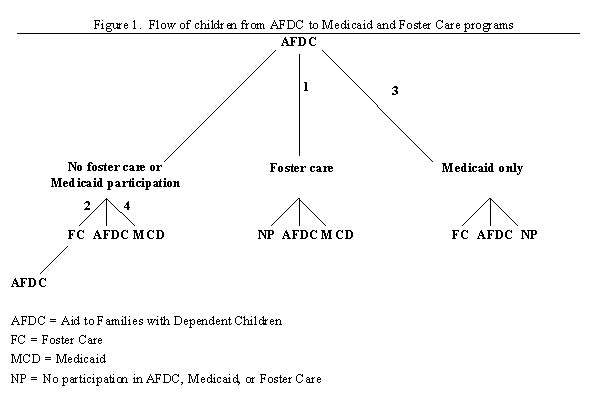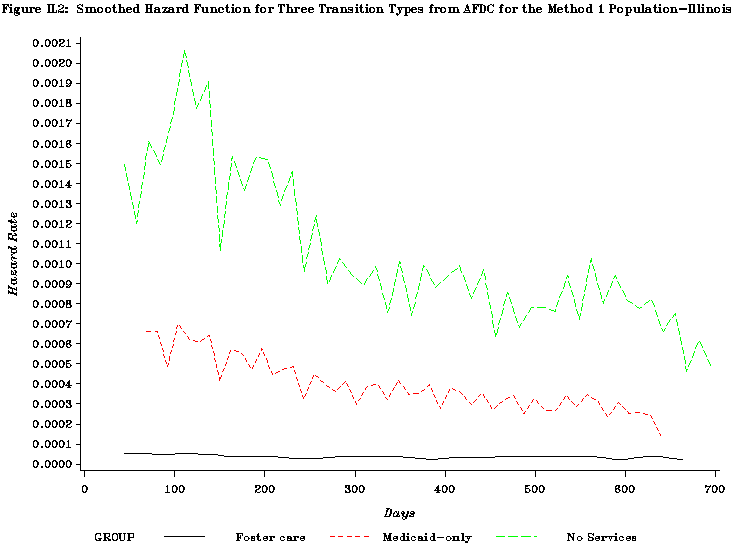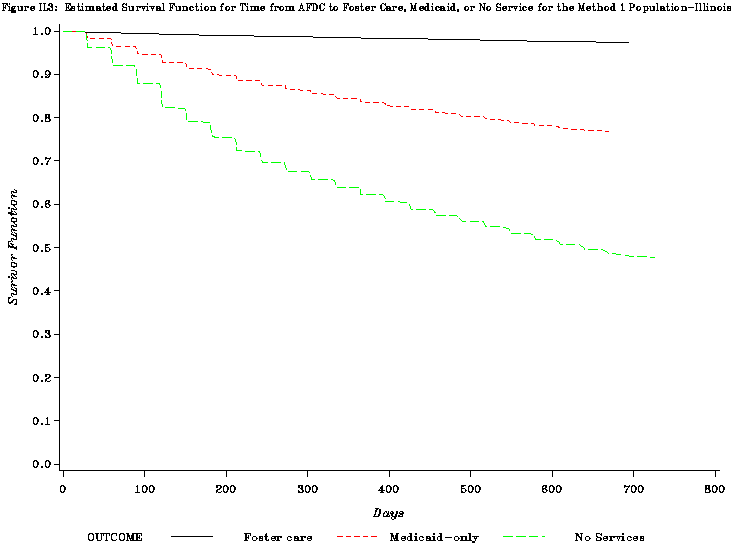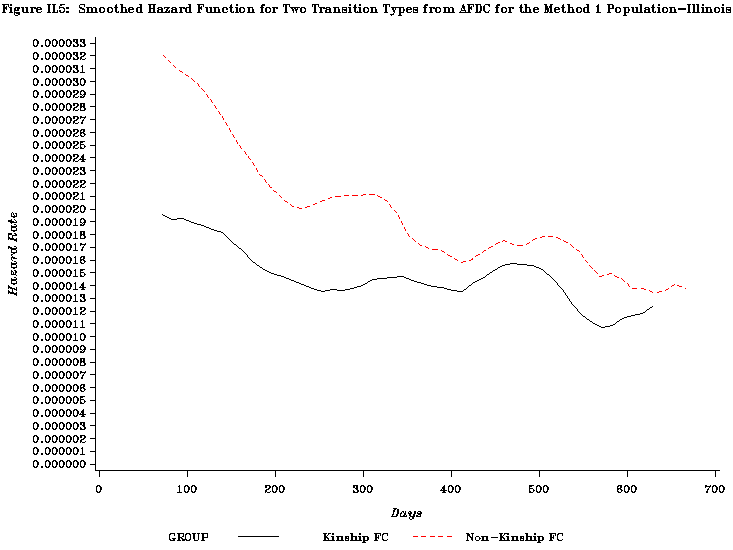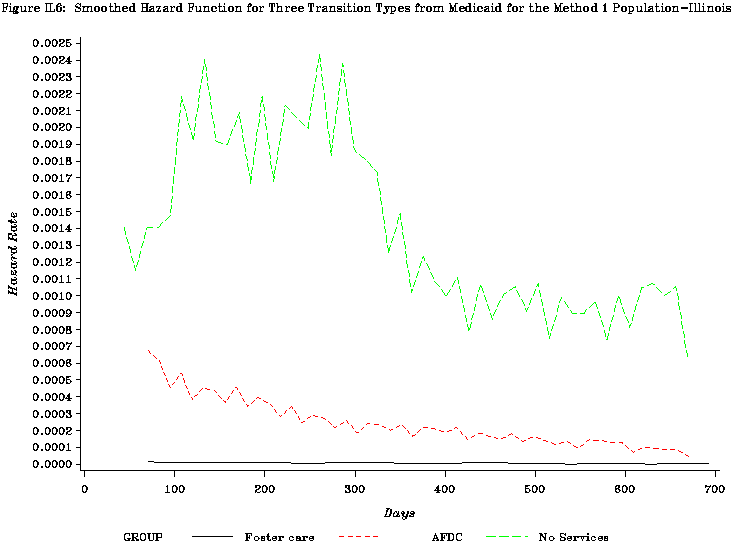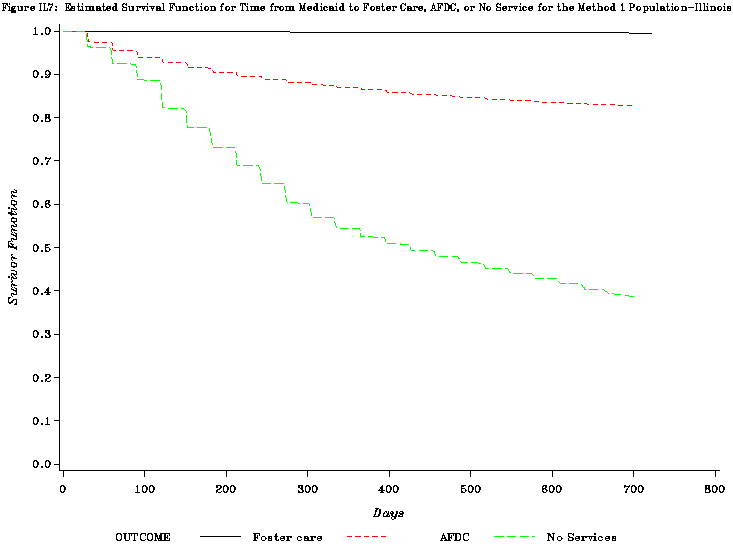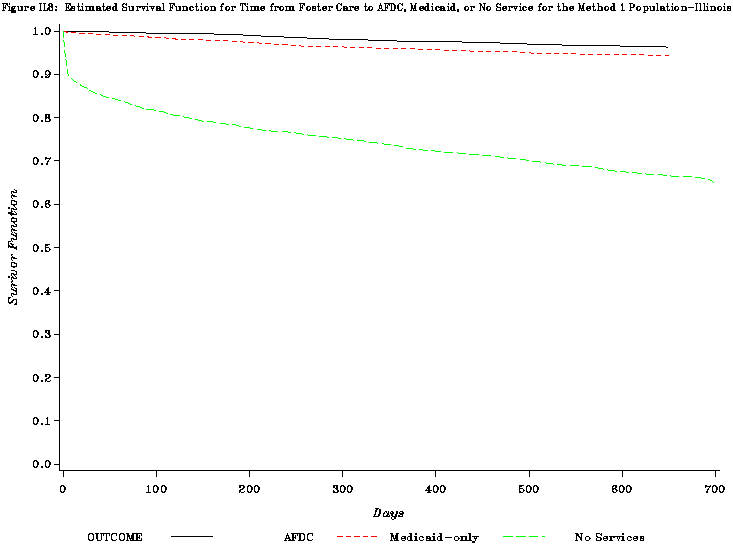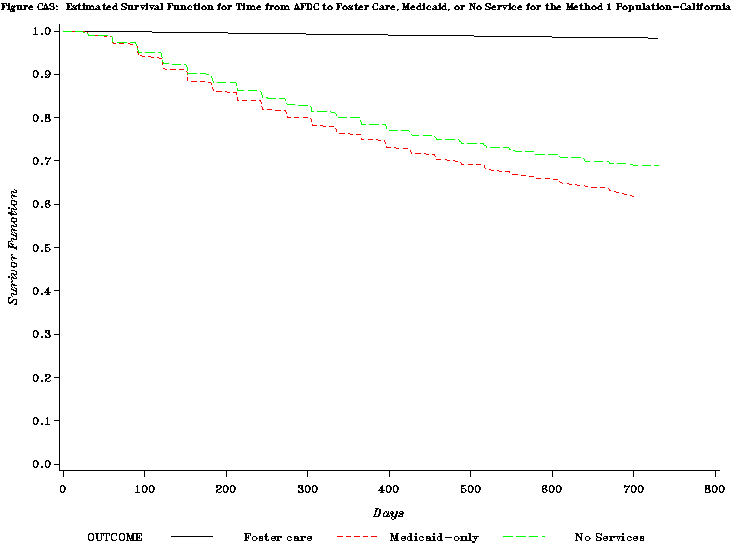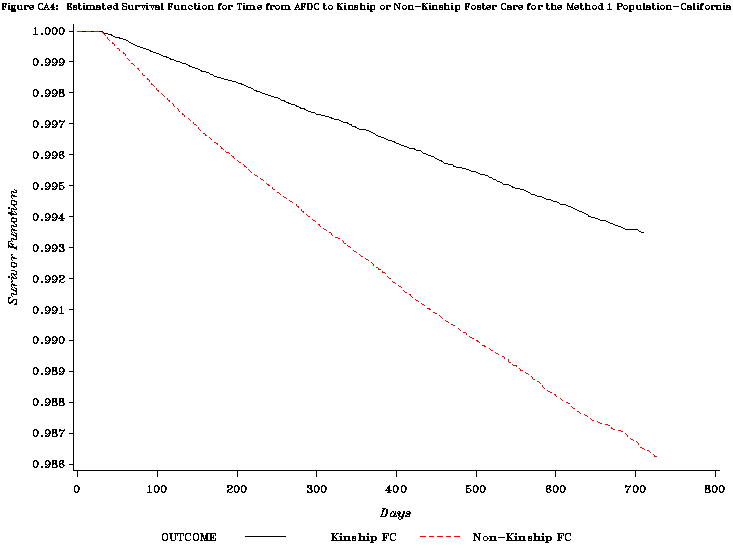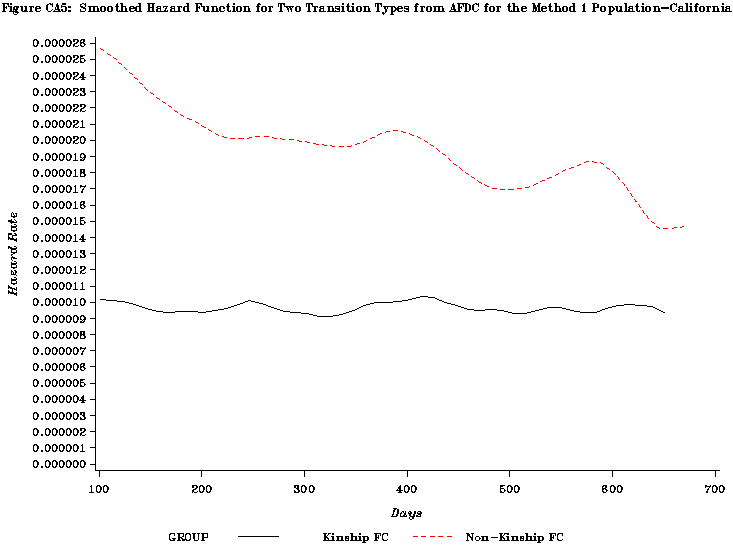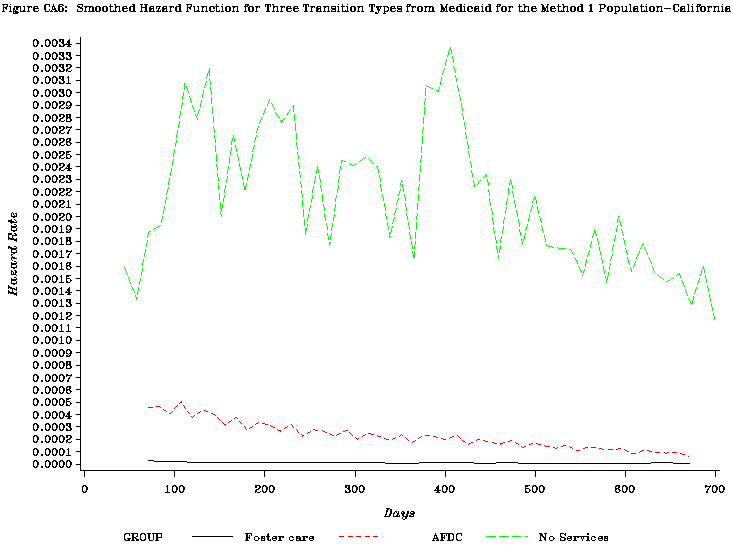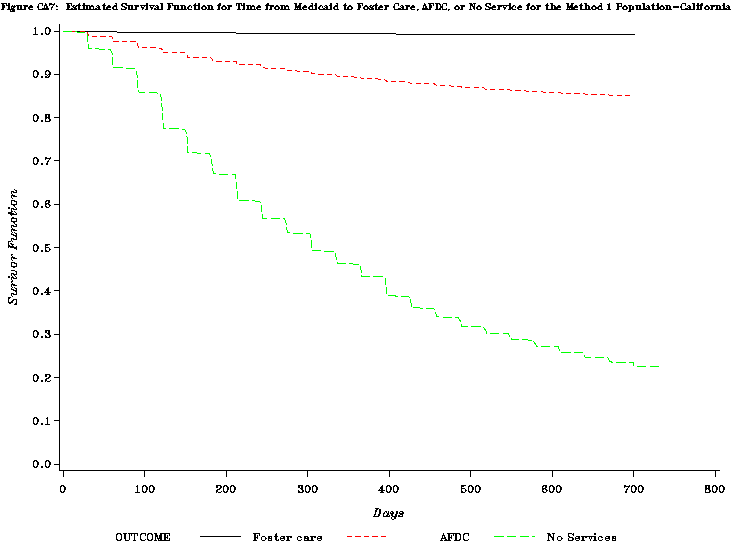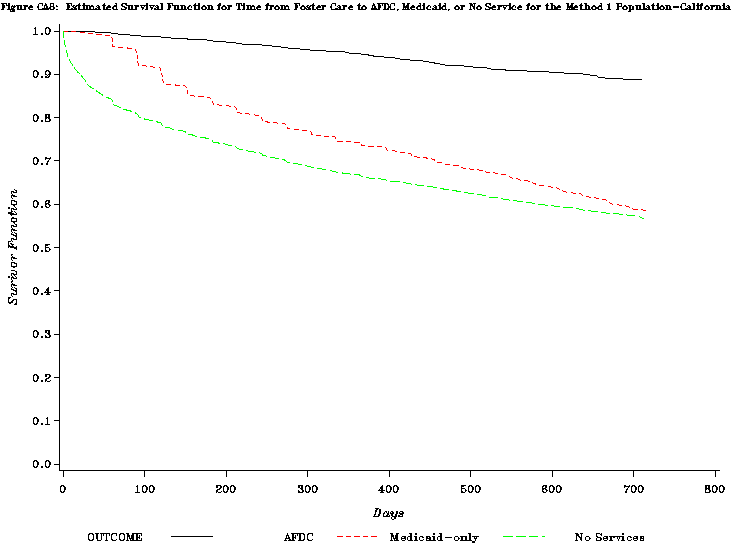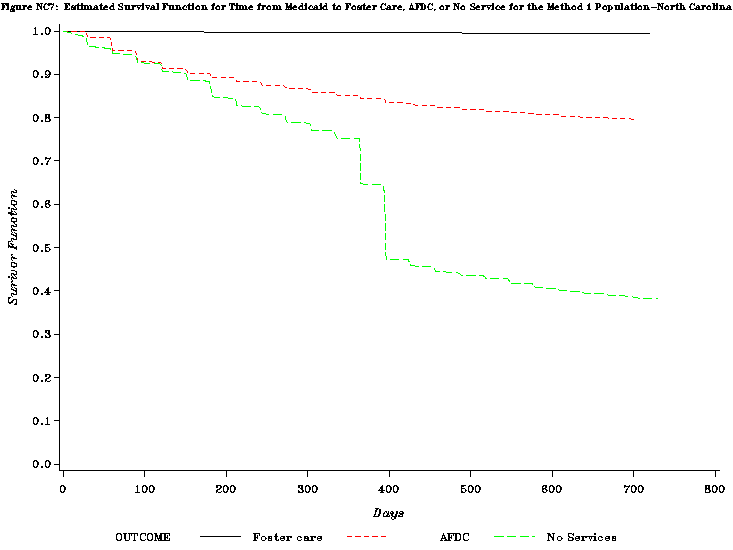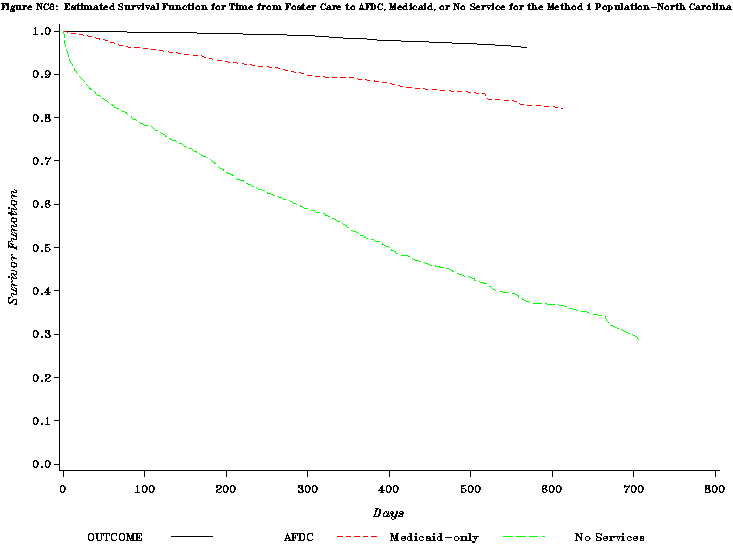Prepared by:
Chapin Hall Center for Children at the University of Chicago
Center for Social Services Research, University of California, Berkeley
School of Social Work, University of North Carolina, Chapel Hill
American Institutes for Research, Prime Contractor
Contract: HHS-100-97-0006, Delivery Order #3
Prepared for:
U.S. Department of Health and Human Services
Office of the Assistant Secretary for Planning and Evaluation
Introduction
Policymakers are typically concerned with the effects of changes in one social program on the use of other programs. Unintended consequences of policy change are the fear of many social programmers, but there is seldom sufficient information to make educated guesses on how the needs of program participants will change when the program changes. This is the case for welfare reform and its effects on social service and safety net programs. In this report, we attempt to construct a baseline against which to measure changes in the income maintenance (from Aid to Families with Dependent Children (AFDC) to Temporary Assistance for Needy Families (TANF)), Medicaid, and foster care program populations and understand the pre-welfare reform movement of children among these programs.
We focus on two types of transitions. The first is designed to better understand the experiences children who may be harmed. For this, we study the transition from a child being part of an AFDC grant to living in foster care. The second is intended to provide more information on how the social safety net is used. For this, we look at how children transition from AFDC and onto Medicaid or leave both AFDC and Medicaid. We address the following questions across the three states:
- At what rate do children who have entered AFDC enter foster care and to what extent does this rate affect the total foster care entry rates? And, subsequently, what is the transition rate back to AFDC for children who enter foster care?
- Are children more likely to enter foster care during or after AFDC receipt? How quickly do foster children enter AFDC after their exit from foster care?
- What factors most significantly affect these transitions?
- If the number of entrants to TANF changes or if the rate of entry to foster care from TANF changes, how many more children will enter foster care?
- How many children continue to receive Medicaid after exiting from TANF? How many children do not participate in either Medicaid or foster care after AFDC exit?
- Of those children who do exit, what percentage transition to only receiving Medicaid?
- What factors affect this transition?
- How might welfare reform affect this transition?
The focus of this study is largely as a baseline against which to study the effects of welfare reform. However, we would also like to emphasize the independent interest of many of our results below as they cast important light on an understudied issue, namely, how families use a variety of welfare programs throughout their lifetimes. There is by now considerable evidence on how individuals transition on and off AFDC, yet little work has been done on addressing whether these individuals continue to use other welfare programs while off AFDC. By addressing the welfare careers of children we can address a series of questions which have largely been ignored in the literature so far. For instance, how important is Medicaid to those who leave AFDC? Do children who leave foster care typically return to AFDC receipt? These questions and others addressed below are of critical interest, not simply in terms of the effects of welfare reform, but more generally providing a more holistic view of the role of welfare programs for the poor.
We examine the experiences of children in AFDC, Medicaid, and foster care in three states: California, Illinois, and North Carolina. These states both represent different geographic regions and a range of policy regimes in welfare and child welfare programs. We have developed comparable data in these states using the administrative data for the three programs.
Income Maintenance Programs and the Child Welfare System
When poor parenting leads to abuse or neglect, the child welfare system intervenes on behalf of a child and, at the extreme, removes the child from the home of the parents and places him or her in foster care. The events that lead to state intervention often develop over time; parental stress over job loss or low income may be cumulative or problems with substance abuse may escalate over time to an eventual breaking point. As researchers, we can most reliably capture the breaking point — when the state intervenes — for the vast majority of children. To do otherwise — to monitor the quality of parenting — would be invasive and costly. With welfare reform, there is concern that the new requirements of the parents may inadvertently affect child well-being negatively and thus increase intervention by the child welfare systems. Our purpose here is to better understand when and how often the child welfare system intervened prior to welfare reform. Such data offer a baseline of knowledge against which to measure the effects, if any, of welfare reform on the child welfare system.
Although there was political consensus in the mid-1990s that reform of the AFDC program was necessary, there was considerable concern that the changes made might affect children adversely. National and state policymakers, federal, state, and local administrators, and child advocates expressed concern about the potential negative effects on child well-being of welfare reform — codified in the Personal Responsibility and Work Opportunity Reconciliation Act of 1996 (PRWORA).(1) On the other hand, there was also reason to believe that working and not just receiving a "handout" would have a positive effect on parental self-image and, therefore, on parenting skills. This, in turn, would lead to improved child well-being.
The intent of welfare reform was to move more people into the workforce and toward greater self-sufficiency. Federal requirements eliminated the entitlement to cash assistance and instituted lifetime limits on receipt of AFDC, now labeled Temporary Assistance for Needy Families (TANF).(2) Although the policies vary among the three states included in this study (California, Illinois, and North Carolina — see Appendix of Tables - Table 1 for comparisons), two requirements apply to all states: a parent may now receive TANF for only five years over his or her lifetime, and recipients must be enrolled in a work "activity" after two years. States can, however, choose to exempt certain individuals or groups (up to 20% of the caseload) and may set their own shorter time limits. The consequence of a grantee failing to abide by these requirements and others established by the states is loss of cash assistance, and, if the states choose, loss of adult Medicaid coverage.
It is clear that, as a result of welfare reform and an improved economy, the economic situation of many families receiving income assistance has changed. As time goes on, more parents' economic status will change. Given time limits and the requirements to work, a significant proportion of the pre-PRWORA caseload will either become employed or be sanctioned and forced to leave income assistance. For those who are employed, we expect their income to increase. Positive changes in the lives of low-income children may arise from a parent's increased self-sufficiency, higher income, and future potential. However, some families will reach their time limits or experience sanctions, reducing their aid and likely reducing household income. In either case, parents' stress levels are likely to fluctuate with work, causing both improvement in self-esteem and increased challenges related to the work and home environments (e.g., transportation and child care). Unemployed parents are likely to feel the stress that accompanies concern about providing the basic needs for their children.
If parents' emotional states improve, better parenting, and a reduced need of the child welfare system to intervene, will likely follow. If their emotional state deteriorates, all else being equal, parental care of children may become less adequate and, in some cases, abusive or neglectful. The children of these parents may not be safe in their homes. The child welfare service system will likely respond by intervening more. The most intrusive response of the child welfare system is to remove a child from his or her parents' custody and place the child in a living arrangement supervised by the child welfare system — foster care.
There may also be an increase in the use of foster care services among the TANF population prior to reaching time limits or incurring sanctions, as families anticipate these events and try to plan for their children. This could lead to "apparent abandonments," in which parents leave children with relatives who can obtain assistance through foster care or through child-only TANF payments. We should also be alert to changes in TANF policy that could result in cases that formerly would have been kinship foster care cases becoming covered under TANF. The distinctions between kinship care in the child welfare system and child-only TANF cases are blurring. In both cases, children are being taken care of relatives. In the child welfare case, custody is taken by the state and the reimbursement to the relative caretaker is significantly higher than that of a child-only case. One trend in the child welfare field currently, is to attempt to reduce the number of children in kinship care by diverting them from formal foster care or moving them into a permanent guardianship status. There are still, however significant difference in reimbursement to the caretakers.
However, those families that improve earnings via employment or other sources may counterbalance the rate of increase in transitions from TANF to foster care. Children who are in foster care in the years following welfare reform may also be affected by their parents' economic situation and their parents' psychological response. Parents' ability to maintain employment is often one signal to juvenile courts and child welfare agencies that they "have gotten their life together." Parents' inability to keep a job, continued substance abuse, or the lack of satisfactory housing may negatively affect the likelihood of a child being reunified with his or her parents.
There have also been other policy changes that are likely to interact with PRWORA. In child welfare, the recent Adoption and Safe Families Act (ASFA), which increases incentives for adoption, and Title IV-E waivers to expand the permanency options in the three states under review (IL, CA, and NC), are likely to change foster care dynamics. Therefore, the transition from foster care to AFDC may also be affected.
One of the biggest concerns for policymakers and welfare administrators is that these interventions will cost society more and result in long-term harm to children. If more children are entering foster care from income maintenance programs in the years following welfare reform, reforms will have had unintended, serious consequences for children, families, and the state, and the policies may need to be revised or services better targeted. Also, if fewer children were discharged from foster care because of changes owing to welfare reform, policymakers may want to reconsider certain elements of reform — both in the income maintenance and child welfare arenas.
Therefore, we need to accurately monitor the movement of children from one program to another and to determine what factors affect that flow. In terms of monitoring the effects of welfare reform on the child welfare system, we do not know exactly when, both in historical terms (how long after welfare reform is implemented) and during the child's experience (before or after income maintenance receipt), the effects will be seen. When the effects are seen in the service system depends on when the effects in the family manifest themselves, and when the system responds to the new conditions in the family.
From a monitoring perspective, we can only observe the latter — when the system responds. Methods to capture when parenting changes would be, at the very least, expensive and intrusive, and perhaps, impossible to implement on a large scale. Therefore, if the response of the child welfare system changes as a result of welfare reform, our analysis may not capture the psychosocial effects of welfare reform on the family. However, there is no reason to expect that the time to respond to abuse or neglect will be longer or shorter as a result of welfare reform. If the process of reporting and investigating abuse and neglect changed as a result of welfare reform, we would be concerned about capturing an unrelated outcome in our data. We know of no reason why this would be true.
In this study, our purpose is to understand better when and how the system-level effects of poor parenting occur prior to welfare reform in order to have a baseline for assessing the effects of reform in addition to simply understanding the careers of children in the service system. Since the system-level effects of poor parenting may happen before or after an AFDC grant ends, because of the variability in how the stress will manifest itself, we must track children before, during, and after their income maintenance and child welfare experience to capture the effects. Therefore, the construction of the study population for assessing the system effects is critical.
The Study Population
Although federal welfare reform was implemented July 1, 1997, many believe that there was an anticipatory effect, and consequently, some AFDC recipients in the early months of 1997 voluntarily stopped their cash assistance although still eligible. Others also believe that potentially eligible recipients avoided applying, believing, mistakenly, that welfare "as we knew it" was a thing of the past. With this in mind, we wanted to select a cohort of recipients who entered AFDC, Medicaid, or foster care near enough to welfare reform to avoid the effects of the changed policies in each state, but not be influenced by any anticipatory effects. We chose children who entered one of the three programs in calendar years 1995 and 1996 and followed them through the end of 1996.
We also wanted a study population that shared similar program experiences. Such shared experiences, such as entry into a program during the same period of time, allow us to control for factors that might affect outcomes. A population of children with entry dates from different historical periods, such as that of a point-in-time population, could also fundamentally change the potential distribution of the likelihood of the events of interest occurring. Understanding factors that affect the flow of children among programs in either case would be difficult. Choosing a point-in-time population would have included children with widely varying durations of participation, as well as varying set of previous programs used. A child in care on a particular day may have been in a particular program for any duration between one day or 17 years. Therefore, the reasons for children entering foster care when they had been receiving AFDC for a considerable period before 1995 would be confounded. We would not know if children were entering foster care because of long-term poverty or because of changes in parenting during a short period of time before foster care entry. Also, we find that children are more likely to enter foster care at the beginning of their AFDC career and that the likelihood decreases over time.
In addition, for the point-in-time population of some programs, we would never expect the majority of the children to leave a program. Another study population might be an exit cohort. Choosing an exit cohort excludes those children who had not formally left the programs, but were nevertheless at risk of entering one of the other programs.(3) Although a transition from foster care to AFDC requires a formal opening of an AFDC case, it does not require a closing of the Medicaid case. Therefore, if we only look at children who exited AFDC, we would miss a transition to foster care of a child receiving AFDC. Because of these issues, one should be careful when comparing the findings in this study to studies with either repeated cross-sections or the "leaver" studies.
In an "entry" cohort study such as the one presented in this report, it is imperative to understand any possible effects of the study population's experiences prior to the "observation" period. In studies that use similar longitudinal methods similar to ours, it is well documented that experiences of the new entry cohorts (those who enter a particular program for the first time) are often quite different from those who had previous service experiences (i.e., re-entries or those who had previous contacts in other service systems). To control for the effect of the previous service experiences, to the extent the longitudinal service data allow, we include those children with no AFDC, Medicaid or foster care two years prior to AFDC entry.
We believe that this study population is the most appropriate one for accurately portraying the movement of children from income maintenance receiving families into foster care. There is a high representation of young children our AFDC group and that is also true of the children that enter foster care. Foster care in the larger states in the U.S. has become a program that targets children under the age of five (Wulczyn et al., 1999).
The Transitions Studied
The diagram below depicts, in general, the transitions that we studied. The first and second levels depict the direct transitions (no time between the two) from AFDC to foster care, Medicaid only, and no participation in any of the three programs. Going from the second to the third levels depict the second transition for the original AFDC cohort. We only have one branch going to the fourth level because it is the only transition at that level that we analyze. Hazard and survival curves for each of these transitions are in the Appendix.
Findings
The transition from AFDC to foster care. Using longitudinal statistical techniques, we find that at two years from entry to AFDC, 2 percent (20/1000) of the California entries, 2.5 (25/1000) percent of the North Carolina entries, and 2.6 percent (26/1000) of the Illinois entries have entered foster care (see table 1) (see figures CA4, NC4, and IL4 in the appendix). Although this seems to be a relatively small number, entries into foster care from the AFDC caseload account for a majority of the entries (about 60%) across the three states. There is also significant variation among the states in the rate of entry to foster care from AFDC, with the rates in North Carolina and Illinois being 25 percent greater than in California.
| Indicator | Illinois | California | North Carolina |
|---|---|---|---|
| % of AFDC cohort that enter FC by 2 years | 2.6% | 2.0% | 2.5% |
| % of FC entries previously in AFDC or Mediciad | 71% | 71% | 68% |
| % of FC entries from AFDC that go directly from AFDC to FC | 85% | 96% | 90% |
It is also the case that the vast majority (85% in Illinois, 96% in California, and 90% in North Carolina) of these children who went to foster care went from an AFDC grant directly to foster care prior to their AFDC case closing (see table 1). The remainder experience an interim of no cash assistance before entry into foster care. Therefore, a typical transition pattern is not one in which an AFDC case closes and an entry to foster care occurs, but rather one in which a child enters foster care from an active AFDC case. This is particularly relevant because many of the current welfare reform evaluations now focus on those TANF cases that have exited. There are likely to be very small numbers of foster care entries from the families that have exited, if this transition pattern remains for the period after welfare reform.
The following findings on the effect of age, type of foster care and county-level poverty were the results of our multivariate analyses (Tables IL1, CA1 and NC1). Infants are nearly three times as likely to enter foster care from an AFDC spell than 15-17 year olds in North Carolina and California and four times as likely in Illinois. We also find that all children on AFDC are more likely to enter foster care early (within the first ten months of their AFDC experience) and that infants exhibit this to the greatest degree. These findings suggest that foster care entry from AFDC is more likely to occur for young children at a time of crisis or stress that has caused a family to move onto the AFDC rolls. Future analysis should include the age of the mother as an additional independent variable because infants who enter foster care are more likely to be born to adolescent or young adult mothers (Goerge and Lee, 1997).
Kinship care in Illinois and California has been used as a formal foster care placement. Therefore, we track kinship care in these two states as a separate outcome. There is some reason to believe that the dynamics of entry to kinship care as opposed to other types of foster care are different, since relatives may be taking care of a child informally prior to the intervention by the child welfare agency. Here we find evidence for this; in California, it is 160% more likely that a child from an AFDC grant enters non-kinship foster care placements than kinship foster care and, in Illinois, the likelihood is 60% greater. Since the overall rate of entry into kinship care has been at least as high as that of non-kinship care in these two states, this likely reflects the fact that children are living with relatives prior to foster care who are not on AFDC.
The effect of county-level poverty on the transition rates varied by state. In California, children from poor counties were more likely to be placed in foster care. However, placement in Los Angeles County seems to account for most of that finding, since it does have a greater than average poverty rate. We found no effect of county poverty levels in Illinois or North Carolina. We also did not get a consistent race effect across the three states. Given that the race and county-level poverty effects are highly correlated, we believe that it is important to look at smaller geographic regions, such as zip codes or even census tracts in order to properly estimate the effect of these two factors.(4)
The transition from foster care to AFDC, Medicaid-only, or no program participation. There are quite different dynamics across the three states in this transition. Of the three states, Illinois has the highest number of all foster care entries still in foster care after two years (61%), a finding that is well-known in child welfare (see table 2). Both California and North Carolina have moved more children out of foster care than Illinois. In California, the most likely transition is from foster care to Medicaid-only (40%). Most North Carolina children (69%) move from foster care to a system exit (no longer receiving AFDC or Medicaid). Relatively few children transition from foster care to AFDC (4% in Illinois, 5% in North Carolina and 11% in California).
Those children who do make the transition from foster care to AFDC are likely to do it very quickly, with 69 percent of the foster care exiters in Illinois, 79 percent in California, and 91 percent in North Carolina doing so within 31 days of exit from foster care. Given that the AFDC pathway out of foster care is an unlikely one, we do not anticipate that welfare reform will have a great effect on the type of foster care exits. It may be, however, that children exit more slowly from foster care than they do now.
We find that the percentage of children who have re-entered AFDC after entering foster care from AFDC is very similar to the percentage of foster children entering AFDC who have not been in AFDC before foster care. These statistics are relatively similar across states. It is unclear why these numbers are similar across states, because of the great variation in how long children stay in foster care. One hypothesis is that the experience of foster care itself changes either the family or the child in ways that prevents certain children from ever returning to the original family. The small percentages of children who return to their families and participate in AFDC may be the cases in which children are reunified with their families very quickly and where the families can be preserved.
| Indicator | Illinois | California | North Carolina |
|---|---|---|---|
| % of FC entries still in care at the end of 2 years | 61% | 34% | 24% |
| % of FC entries that made transition to AFDC | 4% | 11% | 5% |
| % of FC entries that made transition to Medicaid | 6% | 40% | 16% |
| % completely out of system after 2 years | 33% | 33% | 69% |
| % of AFDC entries from FC that do so within 31 days of FC exit | 69% | 79% | 91% |
| % of exits that enter AFDC or Medicaid | 23% | 65% | 23% |
| % of children who have entered FC from AFDC who re-enter AFDC (at 1, 2, and 3 months) | 10.2% 13.3% 16.9% |
18.5% 17% 11.4% |
23.6% 14.7% 34% |
| % of children who have entered FC from AFDC who re-enter AFDC (2 years) | 13.3% | 12.1% | 13.4% |
Implications
The transition dynamics of entry among AFDC cohorts into foster care across states are very similar on many parameters and quite different on a few important ones. The consistency across states in the pre-foster care AFDC and Medicaid participation of foster children suggests that poverty, or perhaps participation in welfare program, plays an important role in the entry of children into foster care. Also, it is clear that infants are at greatest risk and that the birth of a new child is a time when the child welfare system is most likely to intervene in a family's life. The primary differences in the findings are in the percent who enter foster care two years after entry to AFDC; figures in Illinois and North Carolina are about 25 percent greater than California. Also, there is a significant difference between Illinois and California in the likelihood of entry to kinship care compared with non-kinship care, with California children being more likely to enter non-kinship care.
We are able to use these findings to simulate what may happen as a result of changes in the transition from AFDC to foster care. There have been estimates that a one percent increase in the number of children receiving AFDC who end up in foster care would increase the foster care population by 20 percent. Although it is difficult to replicate this exact scenario, we provide in Table 3 below a set of scenarios in which we vary the change in the rate of entry to foster care from TANF and the number of foster children entering TANF cases. These scenarios assume that the number of entries to foster care from Medicaid-only and the number for children who participate in neither TANF nor Medicaid stay constant. The changes in the foster care entries include those children who come to foster care from all previous statuses (TANF, Medicaid-only, and neither of the two).
We find that if an additional one percent of children who begin receiving TANF after welfare reform entered foster care, we would see a 25 percent increase in the number of entries to foster care in 1999 and a 30 percent increase in the year 2000 (scenario #1). Perhaps a more likely scenario would be #4, where the rate of entry to foster care increases, but the number of entries to TANF decreases by 10 percent each year. In such a scenario, we would have much smaller increases to the foster care entries in 1999 (6%) and 2000 (5%). A quite unlikely scenario, given what has already happened since welfare reform, is scenario #5, where both the rate of entry to foster care and the number of entries to TANF increase. The effect on the number of foster care entries under this scenario would be dramatic, with a 51 percent increase in 1999 and a 67 percent increase for 2000.
Alternatively, given the recent decreases in the caseload and the strong employment statistics, we might anticipate that the number of entries to foster care decreases as a result of the positive effects of parents' employment. A one percent decrease in the percentage of children entering foster care from TANF with no accompanying decrease in the number entering TANF would result in a 25 percent decrease in the total number of entries to foster care in 1999 and a 30 percent decrease in 2000 (scenario #7). However, with a decrease in the number of entries to TANF and a decrease in the rate of foster care entry, we would see a 28 percent decrease in the foster care entries in 1999 and 34 percent decrease in 2000.
| Scenario | Increase in rate of entry from TANF to Foster Care | Yearly change in the number of entries to TANF | Change in 1999 Foster Care entries from baseline | Change in 2000 Foster Care entries from baseline |
|---|---|---|---|---|
| Baseline | 14/1000 | None | ||
| 1 | +10/1000 | None | +25% | +30% |
| 2 | +14/1000 | None | +36% | +42% |
| 3 | None | -10% | -21% | -27% |
| 4 | +10/1000 | -10% | +6% | +5% |
| 5 | +10/1000 | +10% | 51% | 67% |
| 6 | -10/1000 | -10% | -28% | -34% |
| 7 | -10/1000 | None | -25% | -30% |
| 8 | -10/1000 | +10% | -25% | -28% |
The prevalence of the transition from foster care back to a cash assistance grant may be affected by the existence in some states of the family cap policies that prohibit TANF payments for children born to parents while on TANF. It is likely that many of the children who enter foster care will be born to mothers already receiving TANF. In this case, they would be ineligible for TANF when they exited foster care. Therefore, the transition from foster care to Medicaid may be an important one to focus on in a follow-up study.
The Experience of A Social Safety Net Program for Children in the Income Maintenance Programs
Over the past 60 years, the United States has developed a series of social safety net programs to aid economically disadvantaged children that involve both cash and in-kind assistance. Much of our understanding of the social safety net is based on an important body of work examining factors that influence exit from the cash assistance. Much less attention has focused on how children and families use non-cash programs such as Medicaid or Food Stamps. Understanding how children use non-cash assistance programs is important to our broader understanding of the role of social safety net programs for the poor. The role of such programs may change as a result of welfare reform cash assistance time limits, and monitoring how children access noncash programs once they are no longer eligible for cash assistance under welfare reform will be critical to our understanding of the effects of welfare reform.
In this section, we focus in particular on whether children use Medicaid or not on exit from cash assistance. We distinguish between children who exit cash assistance and continue to use Medicaid (Medicaid only) and those who do not use Medicaid (system exit). We are therefore taking Medicaid as an example of a social safety net program that is intended to assist children when other sources of support — either through employment or government programs — end. Medicaid has expanded significantly since its implementation to include individuals above the poverty level, as well as preventive services, and mental health services, in addition to the full range of government-financed health care (Kaplan, 1997). As such, it represents a very central part of the social safety net. Perhaps only Food Stamps and WIC can claim to play as important a role in the lives of the children of the poor and working poor.(5)
AFDC families were eligible for non-cash programs such as Medicaid and Food Stamps. As financial circumstances improved, families that were no longer eligible for AFDC were, because of different eligibility standards, typically still eligible for these non-cash benefits directed at both the non-working and working poor. Families were thus eligible, under the Family Support Act of 1988, for Transitional Medicaid Assistance (TMA), for up to 12 months after leaving cash assistance, and children continued to be eligible for Medicaid until their family's income reached approximately 133 percent of the federal poverty line.(6) When family income rose above these levels, families were no longer eligible for noncash benefits and exited this safety system.(7)
Under welfare reform, we will continue to have Medicaid-only families and system exiters. As welfare reform is implemented, it is clear that parents of children will either become employed and eventually leave income maintenance programs, or reach their time limits and become ineligible for income maintenance payments. For some families who leave for employment, income will rise sufficiently to ensure that they are no longer eligible for non-cash programs such as Medicaid, and exit from TANF will be accompanied by simultaneous exit from Medicaid (system exit). For many others reaching time limits without employment or low wage employment will mean they will remain eligible for Medicaid benefits.(8) Furthermore, extended Medicaid coverage under the new Children's Health Insurance Program (CHIP) will likely mean that, in some states, more families will be eligible for Medicaid at higher income thresholds.
The use of Medicaid on departure from cash assistance may change under welfare reform. It is easy to imagine how reform might lead to either increased or decreased use of Medicaid after TANF receipt. With its dual emphasis on work and time limits, welfare reform is likely to result in more and earlier exits from cash assistance to Medicaid-only. Increases in the transition to Medicaid-only may simply occur due to families hitting time limits and being no longer eligible for TANF. Time limits may lead to families leaving TANF without securing such employment. Finally, an important part of the intention of welfare reform was to increase Medicaid assistance to children still eligible. PRWORA and state-specific policies expand and insure TMA (Kaplan, 1997). Thus, because 1) more TANF families will join the ranks of the working poor; 2) time limits and stiffer sanctions for noncompliance with work requirements have been mandated; and, 3) more families will be eligible for Medicaid, we expect a higher percentage of TANF recipients to transition to receiving Medicaid assistance without a cash grant.
On the other hand, Medicaid only transitions may decline with reform if families earn higher incomes post reform (relative to prior) making then less likely to be Medicaid eligible. Similarly, if families are increasingly likely not to take up the Medicaid benefits for which they are eligible, even though they are automatically eligible, welfare reform may result in decreased transitions to Medicaid-only. Of course, even prior to welfare reform, not all Medicaid-eligible children participated in the program after leaving AFDC.(9) For many reasons that are not well quantified, many families do not take advantage of transitional Medicaid benefits. The uptake of Medicaid, when no longer eligible for TANF, is very much affected by the policy and practice in a particular state or local office.
Clearly, the well-being of children may suffer if they choose, for some reason, not to participate in these programs for which they are eligible. If parents become employed and leave TANF, their new jobs may not include health insurance for their children. Continued participation in Medicaid or participation in the new state Child Health Insurance Program (CHIP) ensures continued health insurance. For children in the post-welfare reform era whose parents reach a time limit for cash assistance receipt or are sanctioned for some other reason, continued participation in the Medicaid program is critical to their well-being given their parents' likely reduced economic resources.
Assessing the effect of reform on participation in Medicaid only and system exit is critical to assessing the overall effect of welfare reform on children. This change can only be understood in relation to what the rate of transitions were prior to welfare reform. We examine the rate at which children who were on AFDC prior to welfare reform moved from AFDC to either Medicaid or to no Medicaid. How eligible families are either formally or informally encouraged or diverted from receiving Medicaid benefits will determine much of what we find in this part of the study. During 1995-1996, we note that states often undertook special initiatives to enroll more children into TMA. In particular, California and North Carolina were quite active, while Illinois was not. (In the past two years, 1998 and 1999, Illinois has made a special effort to enroll more children in TMA, and they do show improvement.) We expect that this dynamic will change given the time limits and work incentives of PRWORA and new policies and practices regarding diversion or facilitation. of former TANF clients. Such data records employee participation in the federal Unemployment Insurance program and would enable us to distinguish those who are not receiving benefits because of income ineligibility. In addition, tracking food stamp participation among families will also provide additional information on income.
The Study Population
The study population is the same as in the previous section. Again, we selected a cohort of AFDC recipients participating in years just prior to welfare reform to avoid the effects of the changed policies in each state and the influence of any anticipatory effects. We chose children who entered AFDC in calendar years 1995 and 1996 and followed them through the end of 1996.
The argument for choosing an entry cohort over a point-in-time cohort and exit cohorts remain the same, except that in the transitions from AFDC, we must look for an AFDC case closing before we can classify a child as being in a Medicaid-only status or not in any program. The Medicaid eligibility would look the same in the data regardless of whether the family was receiving AFDC or not.
Findings
Transitions from AFDC to Medicaid or system exit. The indicators that we use to characterize the dynamics of a child's transition from AFDC to Medicaid or leaving these two programs completely vary greatly among the three states. North Carolina reports many more children leaving AFDC within one year of entry (73%) than Illinois (47%) or California (42%) (see table 4). North Carolina, as a result of the short durations, has the highest percentage of children who move to Medicaid at one year (31%), as well as the highest percentage of children (42%) participating in no programs at one year.
Even though the percent of children leaving AFDC at one year is similar in California and Illinois, the particular outcomes vary tremendously. California reports percentages nearly twice those of Illinois for children entering Medicaid from AFDC (23% vs. 12%), while Illinois has twice the percentage of children exiting the system entirely. California, as a result, has the highest percentage of leavers (55%) who receive Medicaid after their exit from AFDC (see table 4).
| Indicator | Illinois | California | North Carolina |
|---|---|---|---|
| % of AFDC cohort that leave AFDC by one year | 47% | 42% | 73% |
| % of AFDC cohort that after one year transition to Medicaid-Only | 12% | 23% | 31% |
| % of AFDC cohort that after one year exit the system | 35% | 19% | 42% |
| Among AFDC exiters at 1 year, the percent who use Medicaid | 26% | 55% | 43% |
Transitions from AFDC to no participation in Medicaid (or foster care) are most likely among the oldest children in all three states (Tables IL1, CA1 and NC1). This suggests, consistent with other findings, that families with the youngest children are the most acutely needy and likely to remain on AFDC longer than families with older children. The fact that adolescents are likely to be part of AFDC grants for a shorter time period may also reflect the fact that they are much more likely than younger children to detach themselves from the family.
The dynamics surrounding the transition to Medicaid from AFDC are somewhat different. Transitions to Medicaid-only are more likely for younger than for older children in North Carolina while the opposite is true in Illinois and California. The Illinois and California findings are somewhat counter-intuitive given the focus on Transitional Medicaid Assistance for younger children. However, this finding is very much a reflection of the study population. Because we follow only new cases, we expect the transition to Medicaid to be higher for those types of cases most likely to exit AFDC. Because in North Carolina a greater percentage of children have left AFDC by the end of one year, a policy that promotes TMA for young children is more apparent because a large number of young and older children have exited AFDC. Because children receive AFDC for longer periods in Illinois and California, we will not see as many children having exited and therefore the transition to TMA is not an issue for them. Again, it is important to understand the experiences of children while on AFDC when analyzing the exit outcomes. If we followed a point-in-time population, it is likely that more of the exiters would be adolescents, since these populations are comprised of more families who have long AFDC durations than entry cohorts. Similarly, if we had followed an exit or "leaver" cohort, we would have expected all of the children to have been considered to receive TMA.
The effects of race on transition to system exit in North Carolina look similar to those observed in California and Illinois. White children are more likely to make a transition to system exit than African-American children, reflecting their shorter lengths of stay on AFDC. African American children are less likely than other groups to transition to Medicaid in all three states.
Implications
It is quite clear from our findings that Medicaid is used quite differently as a safety net program in each of the three states. It is unlikely that the differences we see in these indicators are completely determined by the post-AFDC earnings from employment, although that is likely a factor. In other words, it seems unlikely that the earnings differences for AFDC exiters across the three states would explain the differences in the percent of children exiting AFDC to TMA. The differences in how aggressive these three states were in ensuring that children were covered by Medicaid after AFDC exit may make the most difference in AFDC exit outcomes. During the 1995-1996 time period, North Carolina and California were making special efforts to enroll children in TMA. Again, the fact that duration of AFDC receipt are longer in California and Illinois, due to policies that allow greater income before exit from AFDC, accounts for some of the results around the safety net program.
With its dual emphasis on work and time limits, welfare reform is likely to result in more and earlier exits from cash assistance to Medicaid-only. Families entering the workforce are offered continued health coverage through Medicaid for a transitional period after finding employment. Clients who reach stipulated time limits without first securing employment will continue to be eligible for Medicaid. Furthermore, extended Medicaid coverage under the new Children's Health Insurance Program (CHIP) will likely mean that more families will be eligible for Medicaid at higher income thresholds. Thus, because more TANF families will join the ranks of the working poor, and because time limits and stiffer sanctions for noncompliance with work requirements have been mandated, we expect a higher percentage of TANF recipients to transition to receiving Medicaid assistance without a cash grant.
It is more difficult to predict the effect of reform on movement from cash assistance to system exit. Families in which parents find jobs with health benefits or incomes above the Medicaid and CHIP thresholds may leave cash assistance and Medicaid simultaneously. We anticipate, however, that, on average, we will see a greater increase in transitions from cash assistance to Medicaid-only for those families that leave either because of employment or sanctions. Families that were receiving cash assistance prior to welfare reform and who decide to leave TANF before reaching a time limit, incurring a sanction, or because of increased earnings may be more likely to exit the system completely.
Future Research - A Post-Welfare Reform Comparison
After sufficient time has passed for families to experience fully the effects of welfare reform, it would be beneficial to update this study in order to evaluate the effects of welfare reform in the three states. Although such a study will require more information than what is currently contained in our databases, in addition to careful design, we believe that it is a promising approach given the longitudinal data available for the entire populations of children in the three programs.
Understanding the meaning of changing transition rates will not be straightforward. For example, in the era of AFDC, a permanent transition from cash assistance was likely to be a positive outcome for families because it often corresponded with an increase in income for the family. With welfare reform, and time limits in particular, we can no longer assume that moving off the TANF caseload represents enhanced economic well-being for children. Time limits and sanctions for noncompliance may force families to leave cash assistance without parents first securing employment or other sources of income.(10) Another possibility is that families may choose not to use benefits for which they are eligible (both Medicaid and TANF) or they may preemptively leave TANF in order to save their benefits for future use. Likewise, changes in the movement from TANF to Medicaid only will be difficult to interpret. We have outlined the multiple ways in which we will see a rise or decline in the rate at which these transitions will occur. Unraveling the partial contributions of the range of behavioral change will be the challenge.
Information on what aspects of policy are affecting children directly or indirectly would be crucial. For example, detailed information on the sanctions applied to families and the work experiences of parents during and after welfare receipt will be critical. It will also be necessary to have more in-depth information on the policy, programmatic and economic environment across time for each of the states in order to control for differences across geography and time. Whether data are available or can be collected on the implementation of policy that matches the time frame of the administrative data is an open issue. Many researchers strongly believe that we will not be able to measure policy and programmatic differences across states or, in some cases, counties accurately. The flexibility that is provided to states, and in turn to workers, may be difficult to capture. Methods used to undertake implementation and process evaluation may offer promising strategies to enrich the administrative data.(11)
To better understand the meaning of changing rates of transition from cash assistance to system exit, and from cash assistance to Medicaid-only, future analyses can employ administrative data detailing reasons for case closing in conjunction with Unemployment Insurance (UI) data. The UI data can determine the employment status and income level of former TANF clients. Such data records employee participation in the federal Unemployment Insurance program and would enable us to distinguish those who are not receiving benefits because of income ineligibility. In addition, tracking food stamp participation among families will also provide additional information on income.
In a follow-up to this baseline, it may also be necessary to look at different transitions is more detail. In this report, we focused on the transitions that appeared to be the most common or the most relevant. For example, a focus on the Medicaid population may be necessary if the TANF population continues to become smaller.
It is also possible, and ultimately necessary, to extend this study to other program and social outcomes, such as Food Stamps, WIC, SSI, child abuse and neglect reports, and fertility (adolescent parenthood) and issues of juvenile justice. However, unless we know what is causing the dynamics in these outcomes, independent of antipoverty policy, it will be difficult to tie changes to welfare reform. Although the findings on abuse and neglect reporting should mirror the foster care findings, there may be differences in reporting after welfare reform if families become more self-sufficient. As states and localities become more punitive with juvenile offenders, we may see changes in the juvenile offender population that are not at all related to welfare reform. Cross-state comparisons and perhaps intra-state comparisons may be necessary to determine which policy and programmatic factors interact and influence changes in the wider array of social programs addressing both the problems of children and their basic needs.
References
Allison, Paul D. (1995) Survival Analysis Using the SAS System: A Practical Guide. Cary, NC: SAS Institute.
Beeman, Sandra and Boison, Laura. (1999). Child welfare professionals' attitudes toward kinship care. Child Welfare 78, no 3.
Brady, H., and Snow, B. (1997). Research priorities and data sources for TANF monitoring and evaluation, California policy seminar and UC data. Conference with California Policy Seminar and UC Data, Berkeley, Calif., March 7, 1997.
Cicetti, Dante, and Carlson, Vicki, eds. (1989). Child Maltreatment: Theory and research on the causes and consequences of child abuse and neglect. New York: Cambridge University Press.
Coulton, C. J., Korbin, J., Su, M., and Chow, J. (1995). Community-level factors and child maltreatment rates. Child Development 66: 1262-76.
Courtney, M. (1997) Child welfare in the context of welfare reform, in Kammerman, S. and Kahn, A., Report V Child Welfare in the Context of Welfare Reform. Cross National Studies Research Program.
DHHS, 1999. Patterns of substance use and substance related impairment among participants in the AFDC program. Washington, DC: Department of Health and Human Services, Office of Planning and Evaluation.
Goerge, Robert, and Lee, Bong Joo. (1997). Abuse and neglect of the children. In Rebecca Maynard (Ed.). Kids Having Kids: Economic Costs and Social Consequences of Teen Pregnancy. Washington, DC: Urban Institute Press.
Kaplan, Jan, (1997) Transitional Medicaid Assistance. Welfare Information Network Issue Note.
National Research Council (1993). Understanding child abuse and neglect. Washington, DC: National Academy Press.
Social Legislation Information Service. (1996). Child abuse and neglect: National incidence study. Washington Social Legislation Bulletin, 34(2), 165-68.
Shook, Kristen. (January 1999). Does the loss of welfare income increase the risk of involvement with the child welfare system? Working Paper #6. Chicago: Joint Center for Poverty Research, University of Chicago and Northwestern University.
Reidy, Mairead, Goerge, R., Lee B., and Mackey-Bilaver, L. (October 1998). The dynamics of AFDC, Medicaid, and Food Stamps: A preliminary report. Working Paper #4. Chicago: Joint Center for Poverty Research, University of Chicago and Northwestern University.
Footnotes
1. A pre-PRWORA implementation survey of county welfare directors in California, for example, found that nearly all directors (97%) ranked the impact of TANF on child abuse and neglect as "very important," and a vast majority ranked as important the effect of TANF on the child welfare and foster care system in general (Brady & Snow, 1997).
2. When we report findings prior to welfare reform, we refer to the program as AFDC. When we discuss changes that may arise given welfare reform, we refer to the program as TANF.
3. Our study is in contrast to the TANF exiter evaluations that are currently being conducted by many states. In these studies, a case is being chosen if an adult exited the TANF program in a particular month. In these studies, it is often unclear as to what happened to the program participation of the child.
4. For this study, we did not have access to zip code level address information from all states.
5. It was not feasible to include Food Stamps and WIC in this study because of the lack of availability of the data across the three states.
6. We note that one aspect of the law that is important for our study is that if families did not receive AFDC/TANF for at least three of the six months prior to receiving a job, they are not eligible for TMA.
7. The importance and use of noncash benefits among AFDC leavers has been documented in previous work. In Illinois, for example, over 50 percent of all AFDC leavers continued to claim Medicaid or food stamps on exit (Reidy et al 1998)
8. We note that one aspect of the law that is important for our study is that if families did not receive AFDC/TANF for at least three of the six months prior to receiving a job, they are not eligible for TMA.
9. It should be noted that nearly all children who are part of an AFDC grant are also Medicaid eligible. Exceptions exist when a working parent already has private health insurance and does not provide information on that health insurance to the welfare agency.
10. In California, children will continue to receive cash benefits after their parents reach time limits.
11. A group of researchers led by IRP and the Research Forum are currently preparing a volume on how to do research on the implementation of welfare reform.
Appendix 1 - Data
As noted, we use administrative data from the welfare, Medicaid, and child welfare agencies in three states. Because we were using existing databases, it was imperative that we achieved common definitions and standardized data elements across the three states. We achieved that through close collaboration with researcher groups in each state that are most familiar with the information systems. The individual-level AFDC, Medicaid, and foster care records were linked by child in order to develop "spells" that corresponded to the transitions of interest. A diagram of the database structure for each state illustrates how the databases were constructed.
Entity-Relationship Diagram of Model State databases

Appendix 2 - Guide to Interpreting the Tables and Figures
How to interpret the survival and hazard curves. Although descriptive methods of data analysis provide a good overview of the data, they do little to reduce the complexity of the data and make it difficult to assess the relative likelihood of children from one service system making the transition to either of the other two. Another problem with the descriptive methods is that they only provide information on children who make a particular transition by the end of the two-year observation period. Nothing can be said about children who remain in the original service system at the end of the observation period. Children who are still at risk of transitioning to another service at the end of the observation period represent "censored" data. Censored data poses many problems for standard techniques of statistical analysis. We used survival analysis to deal with the problems associated with censored data while analyzing the likelihood of an event for the entire population at risk of experiencing the event.
In our analysis, it was important to distinguish different types of transitions among the human services. For example, we are interested in whether a child in AFDC is more likely to enter foster care or Medicaid or to receive system exit at all after leaving AFDC. Using survival analysis, we were able to do this using the method known as "competing risks". (Allison, p. 185). Survival analysis is most widely used in medical research, where it is often used to describe the risk of dying from a disease — thus "survival" analysis. A term often used in survival analyses is the hazard rate, or the risk (hazard) of experiencing something given that a person has not yet experienced it (or survived, in this case). In our case, one might say that the more time a child spends in AFDC, the hazard of moving into Medicaid decreases, that is, with every day spent receiving AFDC, the hazard rate goes down.
An example of a survival curve is found in Figure IL3. The curve shows the estimated more than X probability (y axis) that a child will "survive" (or not make the transition) for number of days (x axis). The "failure" — or the opposite of survival — is the estimated probability of making the transition prior to a specified time (again the x axis). Or, in figure 4, one could ask, what is the probability that a child has moved to "system exit" prior to 300 days. The failure rate is thus calculated by subtracting the survival rate from 1. (We speak mainly in terms of failure rates in the text, as in the following sentence: two years after entering AFDC, 20 percent had transitioned from AFDC to Medicaid-only while 50 percent had exited the system).
We also present the estimates of the hazard rate in a graph. By graphing the hazard rate of each of the "competing risks" (in this case each other possible transition, including the move to system exit) in a single graph, one can easily determine which type of transition was most likely over time. An example of the hazard is found in Figure IL2. In this figure, the hazard of exiting the system from AFDC is higher than the hazard of entering either Medicaid or foster care from AFDC. We can also see the declining likelihood of exiting the system or entering Medicaid from AFDC (or negative duration dependence) over time. In contrast, there is little changing in the hazard of entering foster care over time.
How to interpret the "competing risk Cox regression model". In order to understand the influence of individual and community characteristics on the hazard of a particular transition, we used Cox's proportional hazard models. The initial comparison looks at the likelihood of children to enter a selected service. In order to interpret the effect of a particular characteristic (age, race, poverty, gender) on the hazard of a transition, one looks at the risk ratio column. For example, Table NC1 shows that infants are more than 3 times (3.14) as likely than children age 15-17 (the comparison group is always indicated by 1.00) to move from AFDC to foster care, while controlling for the other variables (gender, race, poverty).
A second comparison tests whether or not the effect of a particular characteristic is the same across two different event types. For example, the column in Table IL1 labeled "comparison of coefficients" presents results of a test comparing the coefficients of the AFDC to foster care model with the coefficients of the AFDC to system exit model. If the number in the column meets the .05 significance level we can say that the effect of being an infant, for example, on the hazard of entering foster care is different than the effect on the hazard of entering system exit.
In addition to understanding the correlates of individual transitions, it is often of further interest to ask if, given departure from AFDC, are there factors that make individuals more or less likely to make one versus another transition. We know for example from Figure IL3 that in the aggregate, children who leave AFDC in Illinois are almost three times as likely to go to no services than to Medicaid only. For some individuals, this 3:1 ratio may differ. The 'comparison of coefficients' column presents results of a test comparing the coefficients of the AFDC to Medicaid model with the coefficients of the AFDC to No Services model. Consider the value of 12.1 for infants under the Medicaid only versus No Services column. As this number is positive and significant, we can say that infants are significantly more likely to enter Medicaid versus no services when compared with older children ages 15-17 after controlling for other variables. Note the coefficient does not tell us that infants are more likely to transition to Medicaid only than to No Services (infants may still for example be twice as likely to go to no services than to Medicaid only). We can only say that, given departure from AFDC, they are more likely than their older counterparts to transition to Medicaid-Only than to no services.
Appendix of Tables
| California | Illinois | North Carolina | |||
|---|---|---|---|---|---|
| Eligibility Rules and Time Limits for Two-Parent, Non-Disabled Families | |||||
| 100-hour rule | 1 | ||||
| 30-day waiting period | X(1) | ||||
| Work history rule | |||||
| 6 out of 12 month time-limit | |||||
| State Time Limits, Exemptions,and Extensions(2) | |||||
| Time Limit | 60 months | One-time: 24 months; re-eligible after 24 months |
Lifetime: 60 months |
One-time: 24 out of 60 months |
Lifetime: 60 months |
| Benefit Termination or Reduction | Reduction(3) | Termination | Termination | Termination | Termination |
| Exemption due to: | Not specified | ||||
| – Age | X | X | |||
| – Disability/Illness | X | X | X | ||
| – Caring for disabled person | X | X | X | ||
| – Caring for young child (age) | X (13 years) |
X (5 years)(4) |
|||
| – General hardship or other personal barriers to employment | X | ||||
| – No job available/high local unemployment | |||||
| – Victim of domestic abuse | 7 | ||||
| – Other | 8 | 9 | |||
| Extensions: | |||||
| – Criteria for extension | No extensions | Participation in a "pay after performance" work program | Compliance with personal responsibility contract, or non-compliance with good cause, but unable to find work | No extensions | |
| – Length of extension | Not specified | "Month-to-month" extensions | |||
| Time Limit Implementation Dates | |||||
| 1/98 | One-time: 2/96 |
Lifetime: 7/97 |
One-time: 7/96 |
Lifetime: 1/97 |
|
| California | Illinois | North Carolina | |
|---|---|---|---|
| Work Requirement Exemption Based on Age of Youngest Child(5) | |||
| Exempt while child under age: | 6 months(6) | 1 year | 1 year |
| Limited to 12 total months | |||
| Sanction Policies for Noncompliance with Work Activities Requirements | |||
| Initial Sanction:(7) | |||
| – Amount of Sanction (Partial or Full Benefit Reduction) | Partial | Partial | Partial |
| – Minimum Length of Sanction (No. of months)(8) | Until compliance | Until compliance | 3 months |
| Most Severe Sanction:(9) | |||
| – Amount of Sanction (Partial or Full Benefit Reduction) | Partial | Full | Partial |
| – Minimum Length of Sanction (No. of months)(8) | 6 months | 3 months | 12 months |
| States Requiring Non-Exempt Recipients to Engage in Employment or Unpaid Work Experience | |||
| When is work required? | 18 months(10) | ||
| What is required? | Unsubsidized employment or community service | ||
| Monthly Benefit for a Single Parent with Two Children and No Income | |||
| 1997 TANF benefit | $565(11), (12) | $377(12) | $272 |
| 1996 AFDC benefit | $596(12) | $377(12) | $272 |
| Change in benefit | Reduction of $29 | No change | No change |
| Earnings Disregard Policies for TANF Recipients | |||
| Disregard $225 and 50% of the remainder | Disregard 67% | Disregard $120 and 1/3 of remainder for the first 4 months of earnings; $120 for the next eight months (months 5-12); $90 after 12 months | |
| States with Family Cap Provisions | |||
| No increase in assistance for additional children | X | X | X |
| Partial increase in cash assistance for additional children | |||
| Increase in assistance for additional child provided as voucher | |||
| Increase in cash assistance for additional child provided to third party | |||
| Amount of Child Support Pass-through | |||
| $50 | $50 | State discontinued child support pass-through | |
| Detailed Sanction Rules for Noncompliance with Work Requirements | |||
Source: Urban Institute summary of state TANF decisions as of October 1997. Child Support Pass-through information also comes from the Office of Child Support Enforcement, "Child Support Report," December, 1997.
| Detailed Sanction Rules for Noncompliance with Work Requirements without Good Cause (Length of each sanction is the number of months stated or until compliance, whichever is longer) |
|
|---|---|
| California | |
| First instance of noncompliance | Removal of adult from benefit. |
| Second instance of noncompliance | Removal of adult from benefit for 3 months. |
| Subsequent instances of noncompliance | Removal of adult from benefit for 6 months. (If a parent or caretaker has been subject to a sanction for over 3 months, the county must issue vouchers or vendor payments for at least rent and utilities, until parent is no longer sanctioned.) |
| Illinois | |
| First instance of noncompliance | 50% reduction in benefit. If noncompliance continues for 3 months, termination of benefit. |
| Second instance of noncompliance | 50 % reduction in benefits for 3 months. If noncompliance continues for 3 months, termination of benefits. |
| Subsequent instances of noncompliance | Termination of benefits for 3 months. |
| North Carolina | |
| First instance of noncompliance | $50 reduction in benefits for 3 months. |
| Second instance of noncompliance | $75 reduction in benefits for 3 months. |
| Third instance of noncompliance | $75 reduction in benefits for 6 months. |
| Subsequent instances of noncompliance | $75 reduction in benefits for 12 months. |
1. California: The 30-day waiting period has been modified to a four week waiting period.
2. This table does not list exemptions that are required in all states under PRWORA, namely: 1) families that do not contain an adult receiving assistance; 2) months of assistance received by an adult as a minor child not the head of household or married to the head of household; and 3) any month in which the family lived on an Indian reservation or Alaskan native village with unemployment above 50%. This table also does not list exemption policies related to teen parents or families of non-parent caretaker relatives.
3. After family reaches the time limit, the adult portion of the benefit is eliminated but cash assistance is continued for the children in the unit.
4. Counties have the option to exempt victims of domestic violence.
5. Information in the table is for adult single parents receiving TANF. Special provisions regarding two-parent families and teen custodial parents are not included. The ages listed are for full exemptions. States may also have partial exemptions for parents of young children that require fewer hours of work.
6. Counties have the flexibility to lengthen the exemption age to 12 months or shorten it to 12 weeks. Parents are exempt while the youngest child is under 12 weeks old for all subsequent children.
7. For comparison purposes, the initial sanction refers to the sanction a TANF recipient would receive if the recipient is noncompliant with work requirements for the first time and subsequently complies with the work requirement at the earliest possible time.
8. The length of each sanction, unless otherwise specified, is the number of months stated or until the sanctioned recipient complies with the work requirements, whichever is longer.
9. The most severe sanction may go into effect after a subsequent instance of non-compliance or as a result of continual non-compliance after a specified length of time, depending on the state.
10. The 18 month limit is for applicants who apply on or after 1/1/98. Families receiving assistance before 1/1/98 have a 24 month limit.
11. Amount shown is for non-exempt families.
12. Benefit varies by county or city within the state. The amount shown is the benefit level for the area containing the largest portion of the state population.
Competing Risk Cox Regression Model Estimates:
| Variables | Parameter Estimate | S.E. | p value | risk ratio | Comparison of Coefficients: t value |
|---|---|---|---|---|---|
| AFDC-FC Transition | FC vs. No Services | ||||
| Age | |||||
| Infant | 1.39 | 0.24 | 0.00* | 4.03 | 10.12* |
| Age 1-4 | 0.80 | 0.25 | 0.00* | 2.22 | 4.87* |
| Age 5-9 | 0.35 | 0.26 | 0.19 | 1.42 | 3.20* |
| Age 10-14 | 0.68 | 0.26 | 0.01* | 1.97 | 4.60* |
| Age 15-17 | 1.00 | ||||
| Gender | |||||
| Female | -0.01 | 0.05 | 0.87 | 0.99 | -0.48 |
| Male | 1.00 | ||||
| County Poverty | |||||
| Less than 10% | 1.00 | ||||
| 10-20% in pov | -0.07 | 0.12 | 0.56 | 0.93 | -0.43 |
| 20-30% in pov | -0.12 | 0.11 | 0.25 | 0.89 | 0.28 |
| >30% in pov | -1.97 | 1.01 | 0.05 | 0.14 | -1.85 |
| Race/Ethnicity | |||||
| White | 1.00 | ||||
| Black | 0.49 | 0.07 | 0.00* | 1.63 | 10.76* |
| Hispanic | -0.73 | 0.13 | 0.00* | 0.48 | -5.55* |
| Other | 0.40 | 0.20 | 0.04* | 1.49 | 3.07* |
| AFDC-Medicaid Transition | Med vs. No Services | ||||
| Age | |||||
| Infant | -0.55 | 0.03 | 0.00* | 0.58 | 12.10* |
| Age 1-4 | -0.28 | 0.04 | 0.00* | 0.76 | 3.85* |
| Age 5-9 | -0.19 | 0.04 | 0.00* | 0.83 | 7.06* |
| Age 10-14 | -0.09 | 0.04 | 0.03* | 0.92 | 9.84* |
| Age 15-17 | 1.00 | ||||
| Gender | |||||
| Female | -0.03 | 0.02 | 0.05 | 0.97 | -2.56* |
| Male | 1.00 | ||||
| County Poverty | |||||
| Less than 10% | 1.00 | ||||
| 10-20% in pov | 0.01 | 0.03 | 0.75 | 1.01 | 0.76 |
| 20-30% in pov | -0.66 | 0.03 | 0.00* | 0.52 | -16.27* |
| >30% in pov | -0.97 | 0.16 | 0.00* | 0.38 | -4.85* |
| Race/Ethnicity | |||||
| White | 1.00 | ||||
| Black | -0.61 | 0.02 | 0.00* | 0.54 | -16.54* |
| Hispanic | -0.28 | 0.03 | 0.00* | 0.75 | -8.89* |
| Other | -0.53 | 0.06 | 0.00* | 0.59 | -4.14* |
| AFDC-No service Transition | |||||
| Age | |||||
| Infant | -1.02 | 0.02 | 0.00* | 0.36 | |
| Age 1-4 | -0.44 | 0.02 | 0.00* | 0.64 | |
| Age 5-9 | -0.50 | 0.02 | 0.00* | 0.61 | |
| Age 10-14 | -0.54 | 0.02 | 0.00* | 0.58 | |
| Age 15-17 | 1.00 | ||||
| Gender | |||||
| Female | 0.02 | 0.01 | 0.10 | 1.02 | |
| Male | 1.00 | ||||
| County Poverty | |||||
| Less than 10% | 1.00 | ||||
| 10-20% in pov | -0.02 | 0.02 | 0.39 | 0.98 | |
| 20-30% in pov | -0.15 | 0.02 | 0.00* | 0.86 | |
| >30% in pov | -0.10 | 0.08 | 0.20 | 0.91 | |
| Race/Ethnicity | |||||
| White | 1.00 | ||||
| Black | -0.24 | 0.01 | 0.00* | 0.79 | |
| Hispanic | -0.02 | 0.02 | 0.19 | 0.98 | |
| Other | -0.22 | 0.04 | 0.00* | 0.80 | |
| Note: Baseline levels are indicated as risk ratio of 1. | |||||
| * Estimates are statistically significant at the 0.05 level. | |||||
| Variables | Parameter Estimate | S. E. | p-value | risk ratio | Comparison of Coefficients: t value |
|---|---|---|---|---|---|
| AFDC-FC Transition | FC vs. No Services | ||||
| Age | |||||
| Infant | 1.11 | 0.14 | 0.00* | 3.02 | 18.88* |
| Age 1-4 | 0.55 | 0.14 | 0.00* | 1.73 | 10.38* |
| Age 5-9 | 0.29 | 0.15 | 0.05 | 1.33 | 8.24* |
| Age 10-14 | 0.31 | 0.15 | 0.05 | 1.36 | 8.23* |
| Age 15-17 | 1.00 | ||||
| Gender | |||||
| Female | 0.01 | 0.03 | 0.71 | 1.01 | -0.29 |
| Male | 1.00 | ||||
| County Poverty | |||||
| Less than 10% | 1.00 | ||||
| 10-20% in pov | -0.12 | 0.04 | 0.00* | 0.88 | -11.04* |
| 20-30% in pov | -0.12 | 0.06 | 0.04* | 0.89 | -8.74* |
| >30% in pov | 3.01 | 0.58 | 0.00* | 20.39 | 2.56* |
| Race/Ethnicity | |||||
| White | 1.00 | ||||
| Black | -0.27 | 0.04 | 0.00* | 0.76 | 0.17 |
| Hispanic | -1.07 | 0.04 | 0.00* | 0.34 | -19.56* |
| Other | -1.50 | 0.10 | 0.00* | 0.22 | -10.03* |
| AFDC-Medicaid Transition | Med vs. No Services | ||||
| Age | |||||
| Infant | -0.63 | 0.01 | 0.00* | 0.53 | 47.78* |
| Age 1-4 | -0.32 | 0.01 | 0.00* | 0.72 | 31.87* |
| Age 5-9 | -0.19 | 0.02 | 0.00* | 0.83 | 37.68* |
| Age 10-14 | -0.17 | 0.02 | 0.00* | 0.84 | 37.02* |
| Age 15-17 | 1.00 | ||||
| Gender | |||||
| Female | -0.01 | 0.01 | 0.02* | 0.99 | -4.11* |
| Male | 1.00 | ||||
| County Poverty | |||||
| Less than 10% | 1.00 | ||||
| 10-20% in pov | 0.37 | 0.01 | 0.00* | 1.45 | 5.66* |
| 20-30% in pov | 0.44 | 0.01 | 0.00* | 1.55 | 3.67* |
| >30% in pov | 0.02 | 0.41 | 0.97 | 1.02 | -3.07* |
| Race/Ethnicity | |||||
| White | 1.00 | ||||
| Black | -0.20 | 0.01 | 0.00* | 0.82 | 5.38* |
| Hispanic | -0.12 | 0.01 | 0.00* | 0.89 | 7.31* |
| Other | -0.42 | 0.01 | 0.00* | 0.66 | 6.10* |
| AFDC-No service Transition | |||||
| Age | |||||
| Infant | -1.48 | 0.01 | 0.00 | 0.23 | |
| Age 1-4 | -0.94 | 0.01 | 0.00 | 0.39 | |
| Age 5-9 | -0.94 | 0.01 | 0.00 | 0.39 | |
| Age 10-14 | -0.96 | 0.01 | 0.00 | 0.38 | |
| Age 15-17 | 1.00 | ||||
| Gender | |||||
| Female | 0.02 | 0.01 | 0.00 | 1.02 | |
| Male | 1.00 | ||||
| County Poverty | |||||
| Less than 10% | 1.00 | ||||
| 10-20% in pov | 0.31 | 0.01 | 0.00 | 1.36 | |
| 20-30% in pov | 0.39 | 0.01 | 0.00 | 1.47 | |
| >30% in pov | 1.43 | 0.21 | 0.00 | 4.18 | |
| Race/Ethnicity | |||||
| White | 1.00 | ||||
| Black | -0.28 | 0.01 | 0.00 | 0.76 | |
| Hispanic | -0.20 | 0.01 | 0.00 | 0.82 | |
| Other | -0.53 | 0.01 | 0.00 | 0.59 | |
| Note: Baseline levels are indicated as risk ratio of 1. | |||||
| * Estimates are statistically significant at the 0.05 level. | |||||
| Variables | Parameter Estimate | S. E. | p-value | risk ratio | Comparison of Coefficients: t value |
|---|---|---|---|---|---|
| AFDC-FC Transition | FC vs. No Services | ||||
| Age | |||||
| Infant | 1.14 | 0.27 | 0.00* | 3.14 | 9.36* |
| Age 1-4 | 0.63 | 0.29 | 0.03* | 1.87 | 3.38* |
| Age 5-9 | 0.51 | 0.29 | 0.08* | 1.67 | 3.01* |
| Age 10-14 | 0.43 | 0.30 | 0.15* | 1.54 | 2.66* |
| Age 15-17 | 1.00 | ||||
| Gender | |||||
| Female | -0.21 | 0.08 | 0.01* | 0.81 | -2.28* |
| Male | 1.00 | ||||
| County Poverty | |||||
| Less than 10% | 1.00 | ||||
| 10-20% in pov | -0.08 | 0.11 | 0.48 | 0.92 | -1.08 |
| 20-30% in pov | -0.03 | 0.13 | 0.82 | 0.97 | -0.47 |
| >30% in pov | -0.02 | 0.37 | 0.96 | 0.98 | 0.10 |
| Race/Ethnicity | |||||
| White | 1.00 | ||||
| Black | -0.29 | 0.09 | 0.00* | 0.75 | 1.05 |
| Hispanic | -1.14 | 0.34 | 0.00* | 0.32 | -3.56* |
| Other | -0.03 | 0.17 | 0.87 | 0.97 | 1.77 |
| AFDC-Medicaid Transition | Med vs. No Services | ||||
| Age | |||||
| Infant | 0.21 | 0.04 | 0.00* | 1.23 | 36.77* |
| Age 1-4 | 0.06 | 0.04 | 0.17* | 1.06 | 8.85* |
| Age 5-9 | 0.13 | 0.04 | 0.00* | 1.14 | 10.65* |
| Age 10-14 | 0.13 | 0.04 | 0.00* | 1.14 | 10.38* |
| Age 15-17 | 1.00 | ||||
| Gender | |||||
| Female | -0.00 | 0.02 | 0.77 | 1.00 | 0.92 |
| Male | 1.00 | ||||
| County Poverty | |||||
| Less than 10% | 1.00 | ||||
| 10-20% in pov | 0.18 | 0.02 | 0.00* | 1.20 | 4.88* |
| 20-30% in pov | 0.12 | 0.03 | 0.00* | 1.13 | 2.63* |
| >30% in pov | 0.32 | 0.07 | 0.00* | 1.38 | 4.12* |
| Race/Ethnicity | |||||
| White | 1.00 | ||||
| Black | -0.38 | 0.02 | 0.00* | 0.68 | -0.12 |
| Hispanic | -0.24 | 0.04 | 0.00* | 0.78 | -6.67* |
| Other | 0.09 | 0.03 | 0.00* | 1.10 | 9.66* |
| AFDC-No service Transition | |||||
| Age | |||||
| Infant | -1.42 | 0.02 | 0.00* | 0.24 | |
| Age 1-4 | -0.36 | 0.02 | 0.00* | 0.70 | |
| Age 5-9 | -0.36 | 0.02 | 0.00* | 0.70 | |
| Age 10-14 | -0.37 | 0.02 | 0.00* | 0.69 | |
| Age 15-17 | 1.00 | ||||
| Gender | |||||
| Female | -0.02 | 0.01 | 0.08 | 0.98 | |
| Male | 1.00 | ||||
| County Poverty | |||||
| Less than 10% | 1.00 | ||||
| 10-20% in pov | 0.04 | 0.02 | 0.02* | 1.04 | |
| 20-30% in pov | 0.03 | 0.02 | 0.14 | 1.03 | |
| >30% in pov | -0.06 | 0.06 | 0.37 | 0.95 | |
| Race/Ethnicity | |||||
| White | 1.00 | ||||
| Black | -0.38 | 0.01 | 0.00* | 0.68 | |
| Hispanic | 0.08 | 0.03 | 0.00* | 1.09 | |
| Other | -0.33 | 0.03 | 0.00* | 0.72 | |
| Note: Baseline levels are indicated as risk ratio of 1. | |||||
| * Estimates are statistically significant at the 0.05 level. | |||||
Acknowledgements and Project Collaborators
We would like to acknowledge the support of the Annie E. Casey Foundation for this study. Without their support, we would have completed a significantly less adequate study. The Foundation has had a long-standing commitment to improving the data available to assess child well-being and improving the service systems that help the nation's most vulnerable children.
Without the assistance of the state agencies, this project would also have not been completed. Mark Testa of the Illinois Department of Children and Family Services and Peggy Powers, Dave Gruenenfelder, and Linda Brumleve of the Illinois Department of Human Services were instrumental in assisting the researchers at Chapin Hall. The staff of the California Department of Social Services supported the researchers at U. C. Berkeley. We also thank staff of the California Department of Social Services and the North Carolina Department of Health and Human Services, Division of Social Services and Division of Medicaid Assistance.
Finally, we would like to thank staff at the U.S. Department of Health and Human Services. Laura Radel, the Project Officer, was instrumental in shaping this report and in providing comments on both substance and style. Earlier discussions with Julie Isaacs, Penny Maza, Don Oellerich, and Matt Stagner were critical in shaping the work and final product.
Project Collaborators
Robert M. Goerge, Principal Investigator, Chapin Hall Center for Children at the University of Chicago
Illinois: Bong Joo Lee, Co-P.I., Mairead Reidy, Co-P.I., Lucy Mackey Bilaver; Chapin Hall Center at the University of Chicago
California: Barbara Needell, Co-P.I., Alan Brookhart, Co-P.I., Seon Lee, Esther Kang, and Michael Armijo; Center for Social Services Research, University of California, Berkeley
North Carolina: Dean Duncan, Co-P.I., Lynn Usher, Co-P.I.; School of Social Work, University of North Carolina, Chapel Hill

